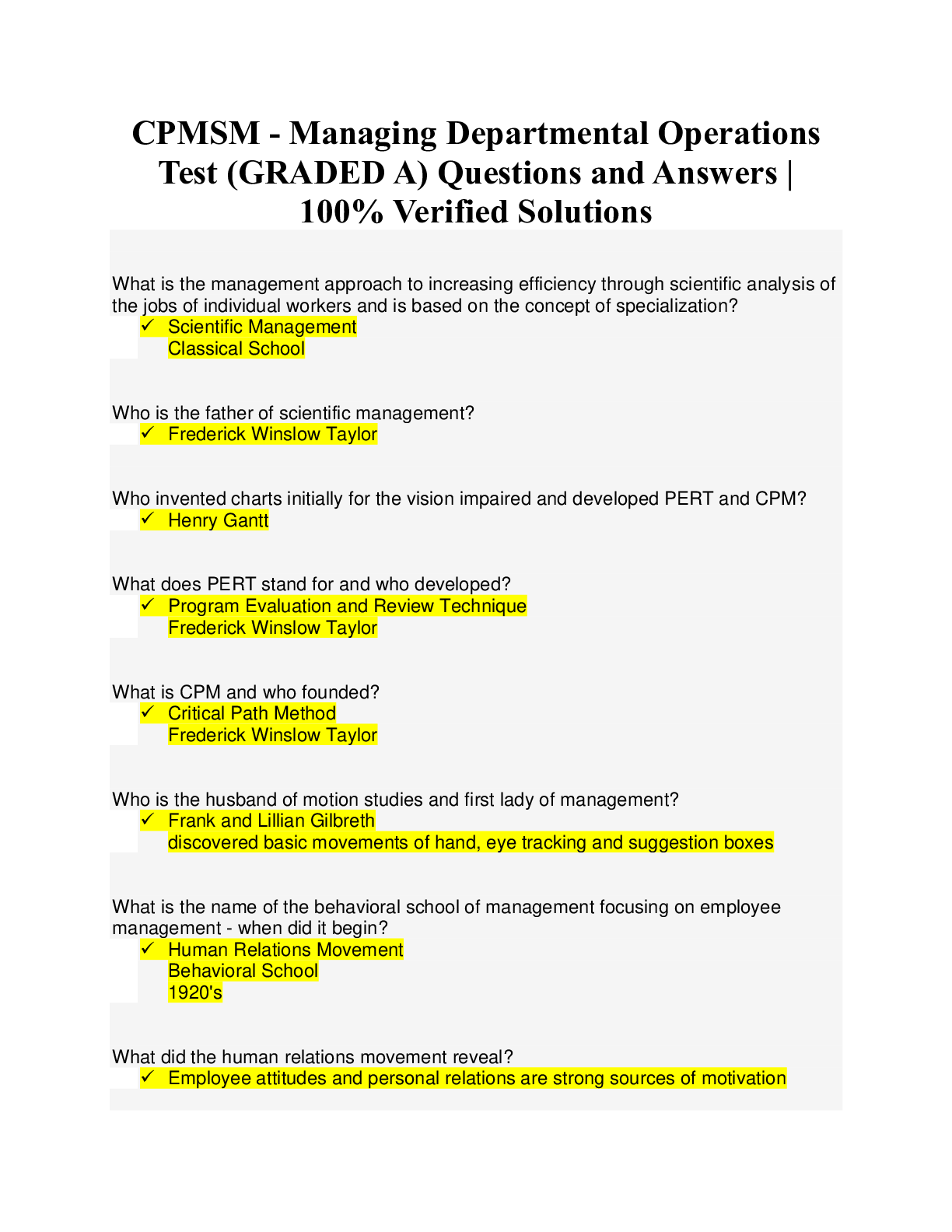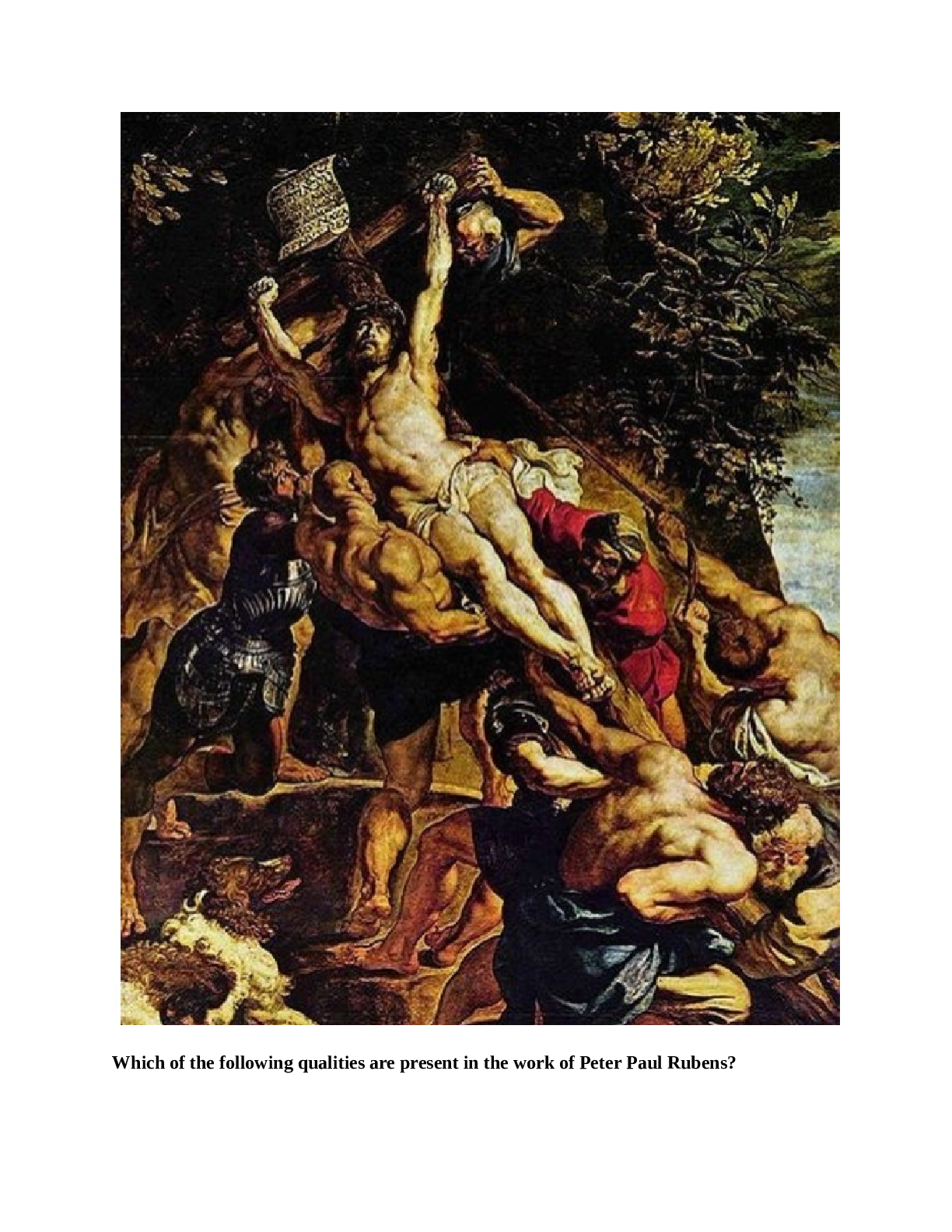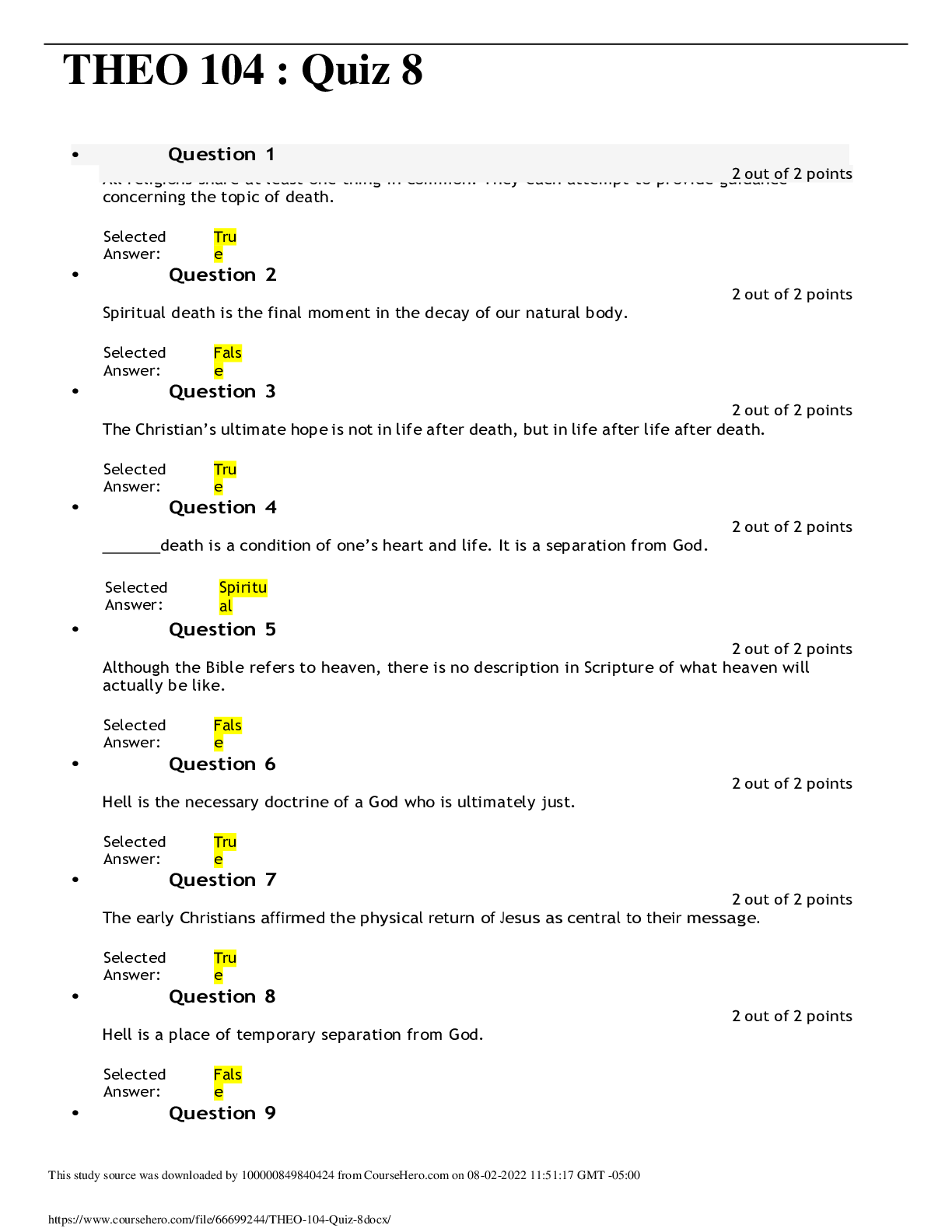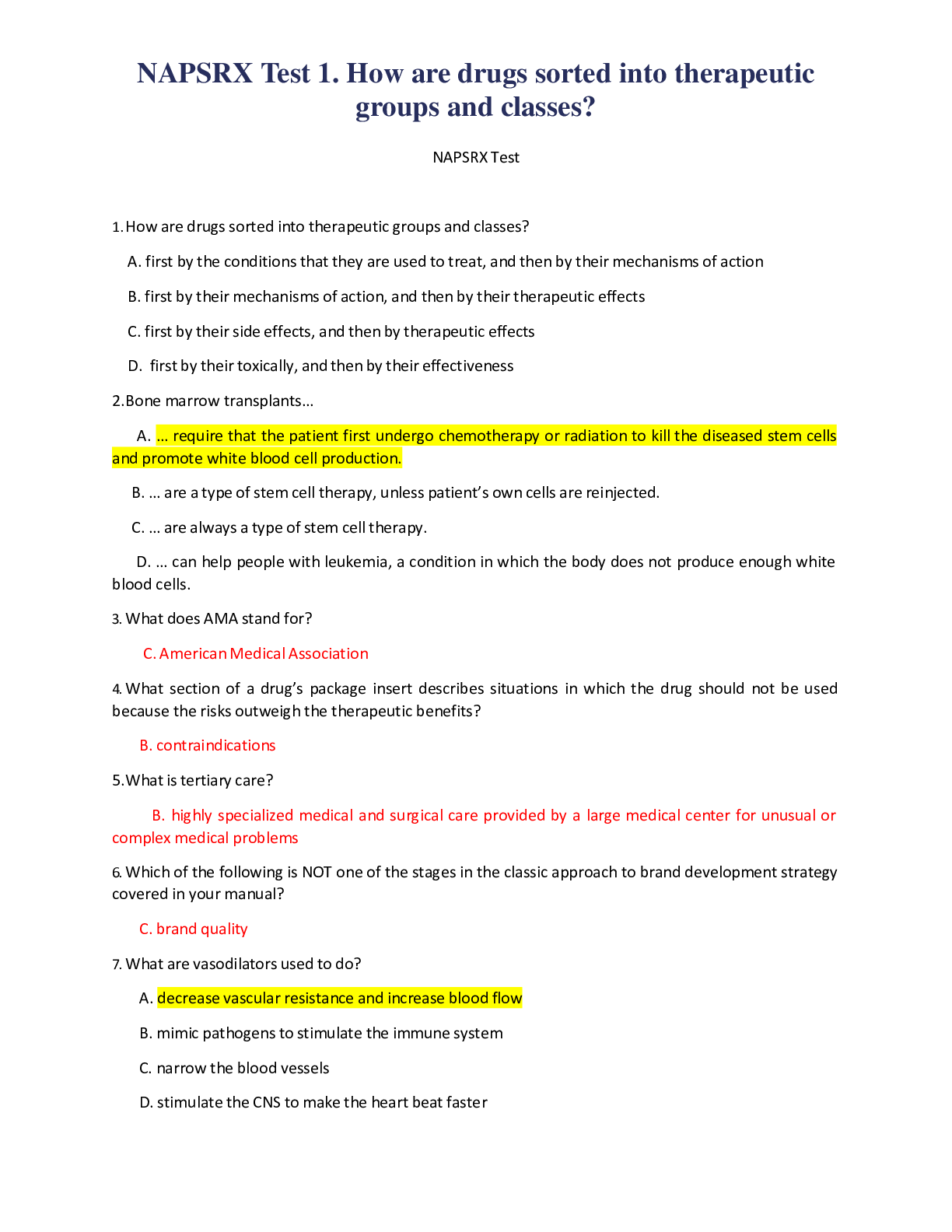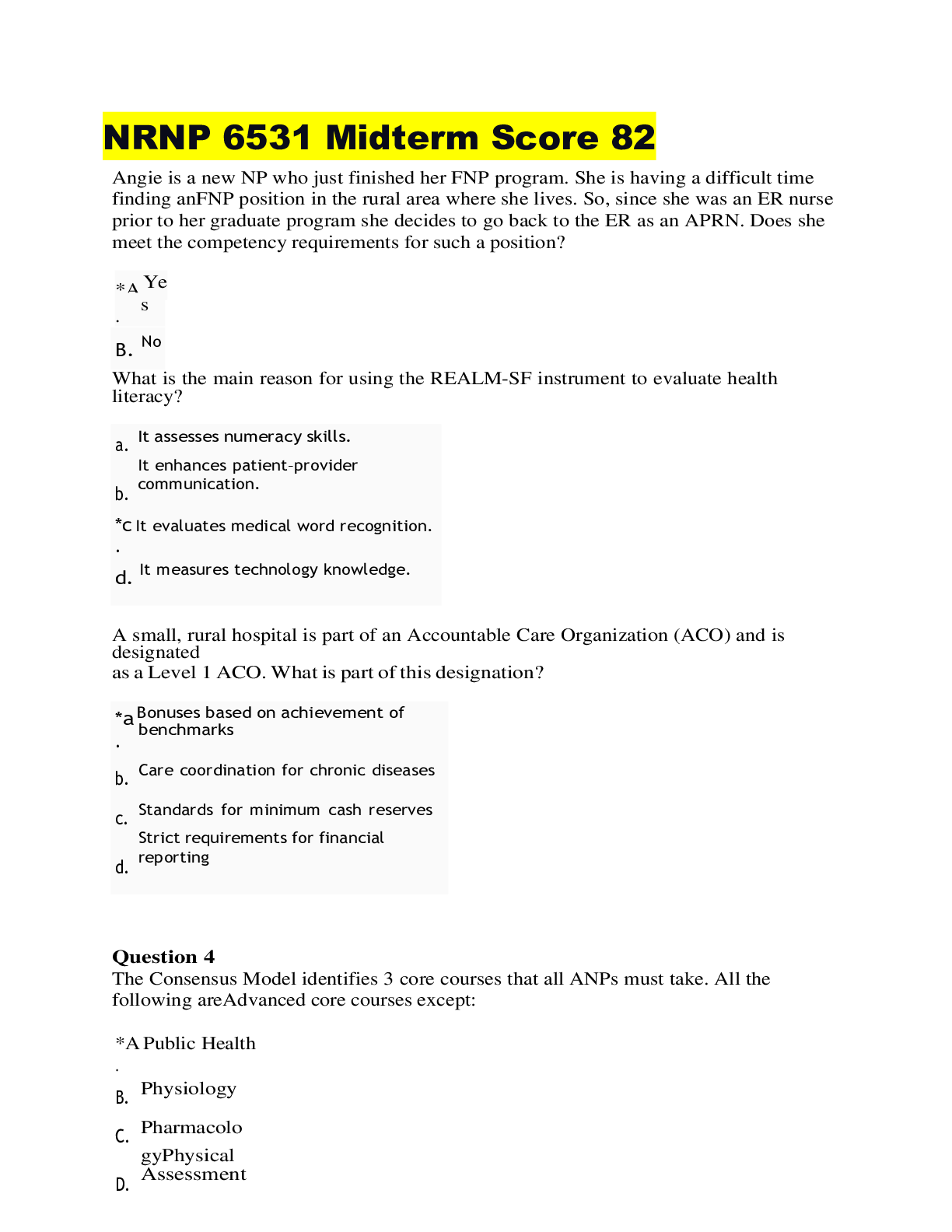Micro Biology > EXAM > BIOD 171 Microbio exam plus answers | 100% CORRECT Solutions | Portage Learning (TEST PREP) (All)
BIOD 171 Microbio exam plus answers | 100% CORRECT Solutions | Portage Learning (TEST PREP)
Document Content and Description Below
1. A virus is classified as a microbe.True. Although viruses are not living and as such are not considered microorganisms, they can, however, be classified as microbes, a more general term that includ... es microorganisms and viruses. 2. True or False: The smallest biological unit of life is the molecule.False. The smallest biological unit of life is the cell. 3. What are the 4 main types of macromolecules found in cells?Proteins, Lipids, Nucleic acids and Polysaccharide 1. Proteins are formed from various combinations of of which there are known forms.Amino acids, 20 2. How many amino acids are classified as being essential amino acids?9 1. What are the two major types of nucleic acids and their roles?There are two major types of nucleic acids: DNA (deoxyribonucleic acid) and RNA (ribonucleic acid). Nucleic acids are chemical molecules that carry genetic information within the cell. DNA contains a vast amount of hereditary information and is responsible for the inheritable characteristics of living organisms. RNA is responsible for deciphering the hereditary information in DNA and using it to synthesize proteins. 1. Complete the following RNA strand and indicate how many bonds are formed for each complementary pair: 3’ GGUCAUCG 5’ 5’ CC AGC 3’ 3’ GGUCAUCG 5’ 5’ CCAGUAGC 3’ There are 2 bonds formed between A and U, and 3 bonds between G and C. 1. The plasma membrane (select all that are true):BD A. Only restricts movement of materials into the cell B. Is often a bilayer comprised of lipids C. Cannot prevent essential nutrients from escaping D. Contains hydrophobic tails pointing inward 2. Carbon, Hydrogen and Oxygen atoms come together to form what primary macromolecule? Give an example.Polysaccharides. Glucose, sucrose and cellulose are all acceptable answers. True of False: The genetic material within a prokaryotic cell is contained within a membrane- enclosed region.False. Only eukaryotic cells contain its genetic material within a nucleus True or False: Prokaryotic cells can be subdivided into Bacteria and Archaea.True Describe the 4 basic bacterial morphologies.Coccus (round/spherical), bacillus (rod), vibrio (curved rod) or spirillum (spiral/corkscrew). True or False: Archaea is noted for its ability to survive under harsh conditions.True. Archaea can often be found in harsh conditions such as high salt levels, high acid conditions, high temperatures and even oxygen-poor conditions. 1. Animalia, Plantae, Fungi and Protista are all classification under what type of organism?B A. Bacteria B. Eukarya C. Archaea D. Virus 2. All multicellular microorganisms classified as Animalia are autotropic.False—they are heterotropic. 3. Microorganisms classified as obtain most of their energy by converting light energy into chemical energy.Plantae 1. A defining characteristic of fungi is the presence of chitin in the cell walls. Which of following also contain chitin? Select all that apply.ACD A. Mushrooms B. Bacteria C. Yeast D. Molds 2. True or False: A defining characteristic of Protista is the inability of colonies to form tissue layers.True. 1. Cell walls are found in which of the following (select all that apply):A, B, C, E A. Plants B. Fungi C. Bacteria D. Mammalian cells E. Algae 2. The function of the ribosome is (select all that apply):B A. Lipid synthesis B. Protein synthesis C. To produce energy (ATP) D. Protein modification and distribution E. Waste disposal via hydrolytic enzymes 1. True or False: Metabolism is a controlled set of biochemical reactions that occur in living organisms in order to maintain life.True. 2. True or False: Enzymes are polysaccharides that catalyze chemical reactions.False. Enzymes are proteins that catalyze chemical reactions. 3. What are usually metal ions known to assists enzyme during the catalysis reaction?Cofactors are usually metal ions and assist enzyme during the catalysis reaction. 1. Define anabolism.Anabolism is the process of building up or biosynthesis of macromolecules from small molecular units into much larger complexes. 2. In order to convert proteins into amino acids which metabolic process would be active? Catabolism would be active as proteins are made up of amino acids. Therefore the process described (proteins into amino acids) is the breakdown, or catabolism of protein. 1. Describe the energy transfer process relative to both ATP and ADP.ATP has the energy (phosphate group) to donate while ADP can accept energy in the form of a phosphate group. Thus, ATP can be reduced (ATP →ADP + Pi) while ADP can be built into ATP (ADP + Pi →ATP). 2. An organism that derives its energy (generates ATP) from photons of light is called a ? Phototrophic microorganism. An organism that derives its energy by removing electrons from elemental sulfur would be classified as a ?Lithotroph 4. A reactive intermediate would be present in which phosphorylation process?B A. Photophosphorylation B. Substrate-level phosphorylation C. Oxidative phosphorylation 1. The catabolism of a single molecule of glucose goes through what 3 distinct transitions?The breakdown of glucose goes through (1) Glycolysis then (2) Fermentation or Respiration and finally through (3) the electron transport chain (ETC). 2. What is the most energetic transition in the catabolism of glucose?The electron transport chain yields 34 ATP while both glycolysis and fermentation (or respiration) each yield only 2 ATP. 3. Identify the reactants of the following chemical equation: Glucose + 2NAD+ → 2 NADH + 2 Pyruvate + 2 ATP The reactants are to the left of the arrow: Glucose and 2NAD+ 4. The presence of what molecule ‘signals’ to the cell that glycolysis is about to start?Glucose-6- phosphate (G6P) 5. True or False: In the absence of oxygen fermentation produces 2 ATP.False. Fermentation only reduces NADH back to NAD+ 1. What is the primary byproduct of the TCA cycle? Select all that apply.CD A. NAD+ B. FAD C. NADH D. FADH2 2. True or False. The reactants of the TCA cycle directly enter and fuel the electron transport system.False. The products of the TCA cycle (reduced electron carriers) enter and drive the production of ATP via the electron transport system. 1. In the absence of glucose, which of the following can be used as alternative energy sources? Select all that apply.A, C, D can all be used as alternative energy sources A. Lactose B. Nucleic acids C. Carbohydrates D. Lipids. 2. For the catabolism of proteins and lipids, which of the following enzymes are used? Select all that apply.B and D. Proteases breakdown proteins while lipases breakdown lipids. A. Ligases B. Proteases C. Transferases D. Lipases 3. True or False. The β-oxidation pathway catabolizes the fatty acid chains of lipids.True 1. True or False. Plants, algae and bacteria all contain chloroplasts.False. Chloroplasts are specific to algae and plants only. 2. The process of carbon fixation begins with which of the following reactants: select all that apply.A, C, D, and E. Carbon fixation uses the ATP/NADPH produced during light reactions to convert CO2 and H2O into useful sources of energy (carbohydrates). A. ATP B. Glyceraldehyde-3-phosphate C. CO2 D. NADPH E. H2O 1. What is one of the main functions of light reactions? Similar to the electron transport chain, one of its main functions is to generate a proton concentration gradient to generate ATP. 2. True or False: Dark reactions can occur in the presence or absence of light. True. The term ‘dark reactions’ (also known as the Calvin Cycle) simply denotes the second stage in photosynthesis—dark reactions do not actually require darkness in order to occur. 1. How many turns (or repititions) of the Calvin Cycle are required to generate one molecule of glucose? Six. 2. Complete the following equation by placing the appropriate numbers where indicated. CO2 + ATP + NADPH + H20 → C6H12O6 + ADP + NADP+ 6 CO2 + 18 ATP + 12 NADPH + 12 H20 → C6H12O6 + 18 ADP + 12 NADP+ 1. Match the following reactions to its corresponding enzyme: 1. A + B → A-B 2. A-B → A + B 3. A- + B →A + B- 4. Ab + C → A + Cb A- Lyases B- Transferases C- Oxioreductaces D- Hydrolases E- Ligases F- Isomerases 1E 1. A + B → A-B Ligases 2A 2. A-B → A + B Lyases 3C 3. A— + B → A + B— Oxioreductaces 4B 4. Ab + C → A + Cb Transferases 1. A micrometer is defined as A. 10-3 B. 10-6 C.10-9 D. 10-12 B. A micrometer is one-millionth of a meter. 2. True or False: A nanometer is longer than a micrometer. False. A nanometer is 1,000 times smaller than a micrometer. 1. Resolution and contrast are two critical factors that influence your ability to see an object. Explain each. Resolution refers to the distance between two objects at which the objects still can be seen as separate. Poor or low resolution means two (or more) objects may appear as one. Contrast is the difference in light absorbance between two objects. Poor contrast gives a high background and makes the visualization of multiple objects difficult. For instance, trying to identify 2 dark colored objects at night (low light = low contrast) versus the same 2 objects in the middle of a sunny afternoon (bright light against 2 dark objects = high contrast). 1. Assuming a constant (non-adjustable) light source power, identify the part of the microscope you would adjust to limit the amount of light entering the microscope. Select all that apply. A. Objective B. Condenser C. Iris diaphragm D. Eye piece C. The iris controls the amount of light that passes through the sample and into the objective lens. Thus, it can be adjusted (opened or closed) to alter the amount of light. 2. What is the total magnification (relative to your eye) of a sample imaged with a 60x objective and a 10x eyepiece? Show your math. 60 x 10 = 600x magnification 1. True or False: A cell that is adherent, flat (thin) and unstained is easily identified using bright field microscopy. False. Adherent, flat cells are almost invisible due to the limits on both resolution and contrast. 2. Which of the following could be seen clearly by the unaided eye? Select all that apply. A. Bacteria with diameter of 24 μm B. Protozoa with diameter of 150 μm C. Virus with a diameter of 0.2 μm D. Skin cell with diameter of 1500 μm B and D. The unaided eye can, on average, clearly resolve objects > 100 μm 1. For each of the following questions select from the list below the single best answer: Phase-Contrast Dark Field Fluorescence Confocal This type of microscope is best suited for visualizing GFP, RFP and YFP proteins.Fluorescence 2. This type of microscope can provide detailed images of live cells without staining.Phase-Contrast 3. This type of microscope is used to greatly increase the contrast between samples and background by reflecting light off of the specimen.Dark Field 4. This type of microscope is capable of capturing images in multiple focal planes, rendering a specimen in 3DConfocal 1. Gram-Positive cells appear in color due to a peptidoglycan layer in the cell wall.Purple; Thick 2. Gram-Negative cells appear in color due to a peptidoglycan layer in the cell wall.Pink; Thin 1. True or False: The distinguishing characteristic of Gram-Negative bacteria is the presence of LPS in the outer membrane.True. 2. True or False: If you wish to study the motility of an organism you cannot heat fix, but you can chemically fix the specimen.False. Both heat and chemical fixation strategies will kill the cell, making motility observations impossible. 1. You want to observe the size and shape of a cell. What is the easiest staining technique that you could perform? Name at least one dye you would use during this process.Simple stain. You could use any of the following: methylene blue, crystal violet, safranin or fuschin. 2. You suspect a patient may have TB. Once a sample has been obtained it is sent off to the lab for an acid-fast stain. If the patient were infected with TB, describe what you would expect to see on the stained slide.You would expect to see red cells (TB+) on a blue background (TB negative). 3. True or False: A Giemsa stain can be used to determine the presence of pathogenic bacteria.True. Pathogenic bacteria would appear pink while non-pathogenic bacteria would appear purple. 1. True or False: Differential media is best suited for distinguishing between two similar species of bacteria.True. Growth media does not contain restrictive factors, while selective media is best used to encourage the growth of one microbe while simultaneously discouraging the growth of the other. Since two similar species of microbes are being studied they must be differentiated under similar but just slightly different conditions (differential media). 2. A researcher is asked to determine if a sample contains Neisseria meningitides. Knowing Neisseria meningitides is slow growing and other foreign microbes may also be present in the culture, which type of media would be best suited:C A. Growth media B. Differential media C. Selective media D. Selective and Differential media 1. True or False: LB agar is classified as a selective, non-differential media.False. LB agar is the most basic type of agar and like LB media supports the growth of virtually all microbes without restriction. 2. What is agar used for in microbiology?Agar is used to create a solid, smooth surface on which microbes can grow. 1. Match the following hemolytic class with its description of activity. Alpha hemolysis- Incomplete hemolytic activity. Beta- Complete, Gamma- No hemolytic 1. Columbia CNA agar is most closely related to which media:C A. Trypticase Soy Agar B. MacConkey Agar C. Blood agar D. EMB agar 2. True or False: Chocolate agar gets its brown color from cocoa to produce an enriched media.False. Chocolate (cocoa) is never added to the media. The name is derived simply based on the color that actually comes from the presence of ‘cooked’ (lysed) red blood cells in the media. 3. A researcher is studying a strain of E. coli currently growing on a MacConkey plate. However, the researcher can’t remember if E. coli is Gram-Positive or Gram-Negative. Would a Gram stain be necessary to confirm? Why or why not?No. A Gram stain would not be necessary, as only Gram- Negative microbes will grow on MacConkey agar. Thus, E. coli is a Gram-Negative microbe. 1. In an attempt to detect the presence of the pathogenic strain of E. coli O157:H7, a researcher spread a culture onto a MacConkey agar with failed results. What type of agar should they (correctly) try next? Why?The microbe should be plated on SMAC (Sorbitol-MacConkey agar) as it is specifically formulated to detect O157:H7. Pathogenic E. coli (O157:H7) cannot ferment sorbitol while non-pathogenic E. coli can ferment both soribitol and lactose. Therefore, colonies that ferment (acidic conditions; non-pathogenic) can be differentiated from non-fermenters (neutral to basic conditions; pathogenic). 1. What is the Gram status (Positive or Negative) of microbes growing on Eosin Methylene Blue (EMB) agar plates?Gram-Negative. EMB plates specifically restrict the growth of Gram- Positive bacteria. 2. Mannitol salt agar will turn what color in the presence of the pathogenic strain Staphylococcus aureus?Yellow. Pathogenic Staph aureus will turn the agar from red to yellow. 1. What is the process of spreading a bacterial culture onto a petri dish?Plating. 2. In order to visual individual colonies of bacteria would you culture your sample in a liquid media or on a solid (agar) media? Why?Solid (agar) media. The primary advantage is that cells are held into place. When grown in a nutrient broth, bacterial cells can multiply but are free to move around in solution. When grown on agar within a petri dish the fixed in such as way as to form colonies. 3. True or False? The visualization of colonies on a petri dish represents bacterial cells that have often multiplied a million times over.True. To form a bacterial colony the initial cell must have multiplied many times over, often greater than a million, in order for the naked eye to resolve it. 1. True or False. The purpose of a quadrant streak is to produce individual colonies of a bacterial population.True. The purpose of the quadrant streak is to generate individual colonies such that a single (pure) bacterial sample can be isolated. 2. A dilution gradient is formed when carrying out what generalize plating strategy?A quadrant (aka phase-dilution) streak. The resulting gradient should always contain within it the growth of individual colonies. 3. In what phase of a dilution streak would you expect to find the highest concentration of bacteria, P2 or P4?P2 (Phase 2) would contain a higher concentration of bacteria than Phase 4 (P4). The phases rank (from highest to lowest), P1 > P2 > P3 > P4. 1. True or False. When performing a dilution streak a new (or sterilized) loop must be used for each phase.True. Failure to do so would prevent the establishment of a dilution gradient, as the same bacterial concentration would be spread across both phase regions. 2. In order to encourage growth of a slow growing microbe what might a researcher do during a phase dilution streak?A researcher may either (1) opt to perform only a 3-phase dilution streak or (2) pass the loop through the previous phase multiple times (as opposed to only once). 3. True or False. To restrict the growth of a pathogenic microbe a researcher might decrease an incubator from 37°C to 25°C.True. Pathogenic strains of bacteria tend to grow faster than non- pathogenic strains at 37°C, so researchers may set incubators at 25°C to restrict its growth. When given an unknown bacterial sample the first step is to expand the current bacterial population. Which form of media best suites this need? Why? A. MSA agar B. LB media containing ampicillin and neomycin C. MacConkey agar D. Blood agar D. Blood agar. All other options (A, B and C) are all forms of selective media, meaning they may potentially inhibit the growth of the unknown sample. Although blood agar is considered a differential media, it is, most importantly, a non-selective media. Given the alternatives, this is the best option. 1. Define the concept of universal precautions.Universal precautions means any and all samples, whether known or unknown, are to be treated as potentially hazardous (or pathogenic) materials. 2. List at least 3 observations a researcher would be sure to note while assessing an unknown microbial sample A lab researcher would be certain to note:1. Size and shape2. Any observable motility3. Gram status (positive or negative)4. The presence of any chemical reactions5. Changes in color localized to the organism or the surrounding media6. Capture (or draw) images of any of the characteristics described above 1. While observing an unknown sample of limited amounts, a researcher must determine the following observations: (1) the presence of any motility and (2) its Gram status using the same sample—the liquid sample cannot be divided. Which would you determine first and why?You must determine motility before determining the Gram status. Motility requires a wet mount, while Gram staining requires heat fixing the sample. If one were to begin with the Gram stain the heat fixation process would kill the organism, making any observations regarding motility impossible. The correct approach would be to place the liquid culture on a glass slide and determine its motility status. Next, the same liquid culture can be heat fixed and Gram stained. 2. A facultative anaerobe is a microorganism capable of growth under what conditions?A facultative anaerobe is capable of growth under aerobic (with oxygen) and anaerobic (without oxygen) conditions. 1. As Streptococcus is catalase negative would it thrive or die in the presence of peroxides? Why? Streptococcus would not survive in the presence of peroxides—it is unable to breakdown peroxides (catalase negative). Left unchecked, peroxides would damage the cellular integrity of Strep causing lysis/cell death. 2. Streptococcus is most often streaked onto C A. Chocolate agar B. EMB agar C. Blood agar D. Spirit Blue agar 3. True or False. The Lancefield groups are used to subdivide antigenic groups of gamma-hemolytic Streptococcus.False. The Lancefield groupings are used to subdivide beta-hemolytic Strep. 4. Greater than 90% of all human streptococcal infections belong to:C (group A) A. Group B B. Group D C. Group A D. Group C 5. Left untreated, strep throat can progress to , which displays hemolytic activity.C A. Strep. Pharyngitis; beta B. Strep. Septicemia; gamma C. Rheumatic fever; beta D. Strep. Pharyngitis; alpha 1. True or False. Under most circumstances, staphylococcus can be found in ~30% of human population where it remains pathogenic.False. While staphylococcus can be found in ~30% of the human population, it remains non-symptomatic. 2. When a bacterium neither harms nor benefits from the host from which it obtains nutrients, it is referred to as being .Commensal. 3. In order to differential screen staphylococcus species, agar plates should contain what additive? Bile salts. Staphylococcus species are capable of growth in the presence of bile salts. Folliculitis- DPus-filled lesions on skin or hair Scladed-skin syndrome- ERuptured pustules; treated with Penicillin Impetigo- AChildhood skin disease near mouth/nose Conjunctivitis- BInfection of thin, transparent scleral tissue Opthalmia Neonatorum- C infection occurs at time of birth 2. True or False. The causative agent of conjunctivitis can be either bacterial or viral.True. There are bacterial (staph) and viral forms of conjunctivitis, both resulting in the inflammation of the conjunctiva and ‘pink eye.’ 1. True or False. An acid-fast stain is best suited to identify Tuberculosis (as opposed to a Gram stain).True. TB shows a poor Gram stain and should be screened via an acid-fast stain. 2. True or False. Although TB must be inhaled and reside in the lung in order to cause infection, TB can also spread to the brain, spine and kidneys.True. TB can move systemically through the blood to infect other areas (brain, spine and kidney). However, when located outside of the lung, TB tends to be non-infectious. 1. True or False. Directly ingesting clostridium or its associated spores will not cause illness in adults.True. Only the direct ingestion of the pre-formed toxin will cause disease. 2. A 5-month-old child is given honey at breakfast and begins showing symptoms consistent with botulism. Would the child’s illness be classified as foodborne, infant or wound botulism?Infant. Although food (honey) is consumed, foodborne botulism is derived from improperly canned, low acid foods under anaerobic conditions. Such conditions were not described. No puncture wounds or injuries were described, ruling out wound. The child is suffering from infant botulism, as honey is a potential carrier of clostridium. The intestinal track of young children is still developing and clostridium is able to colonize and produce the associated toxin. 1. True or False. There are currently no cures for tetanus.True. Although the symptoms can be treated it is only to manage the discomfort not to cure. 2. Identify the medical condition characterized by robust carbohydrate fermentation under anaerobic conditions, swelling of the infected areas and fever.Gas gangrene. The key identifier here is the robust carbohydrate fermentation, which manifests as intense gas production and swelling— both trademark conditions of gas gangrene. 3. The alpha-toxin perfringolysin is associated with which medical condition caused by Gram-positive anaerobic bacteria?C. Gas gangrene. The bacterium that produces the alpha toxin perfringolysin is aptly named Clostridium perfringens. A. Tetanus B. Botulism C. Gas gangrene D. Leprosy 1. You develop a fever, chills and pneumonia after recently using a warm midst vaporizer in an attempt to open your sinuses. What bacterial disease would a doctor suspect is causing your symptoms? Would the doctor suspect you contracted it from touching (potentially) contaminated doorknobs?Legionnaires. No—legionella cannot be spread simply by direct contact between people. Legionella can only be transmitted through droplets small enough to be breathed in. 2. True or False. Bubonic plague is often characterized by painfully swollen lymph nodes.True. 3. Which form of the plague is highly virulent? What does it target?Pneumonic plague is highly virulent and targets the respiratory (lungs) system. 2. Gonnorrhea is caused by: A A. Diplococcic bacteria B. Staphylococcus bacteria C. Gram-Negative spirochete D. RNA virus 3. True or False. Chlamydia trachomatis can be grown on an agar plate alone.False. Chlyamdia is an obligate parasite and requires a host (viable cells) for its growth. 4. Match the following diseases with their respective symptoms if left untreated: Gonorrhea C Syphilis A Chlamydia E A. Paralysis, blindness and dementia B. Painfully swollen lymph nodes C. Cardiac and neurological complications D. Respiratory failure associated with lock-jaw E. Infertility and pelvic inflammatory disease. F. Sore throat, ocular discharge and fever 1. True or False. Although viruses may contain their genome within an enclosed space (much like the nucleus of a cell) it is considered neither eukaryotic nor prokaryotic.True. 2. Describe the two basic components of a virus.A virus has (1) genomic material comprised of either DNA or RNA and (2) a capsid, a membrane-like protective structure that contains the genetic material, similar to the nucleus of a eukaryotic cell. 1. The surrounds the capsid of some viruses.Envelope. 2. True or False. You would expect to see a viral envelope on a virus infecting a plant cell.False. The overwhelming majority of animal viruses are enveloped whereas the majority of plant or bacteria-infecting viruses are not. 3. Rank the following viruses based on their size from largest to smallest: Orthomyxovirus Poliovirus Variolavirus Variolavirus (~200nm) > Orthomyxovirus (100-150nm) > Poliovirus (~30nm) 1. True or False: Viral replication occurs after it attaches and enters the host cell.True. The viral genome is never replicated before attachment and entry. 2. Place the following viral life cycle steps in order beginning with viral attachment and provide a description of each step. Uncoating: Release: Replication: Attachment: Entry: New infection: 3- Uncoating: the viral capsid disassembles 5-Release: New virus particles are produced and leave the cell 4-Replication: the viral genome is the ‘blueprint’ to make copies of itself 1-Attachment: viral receptors bind to host proteins on the surface of the cell 2-Entry: the virus fuses with the host membrane and enters the cell 6-New infection: newly produced viruses that left the host cell now go on to infect new cells. 1. A virus that infects bacteria is called a and contains a -side polygon capsid.Bacteriophage; 20-sided 2. True or False. Structurally, bacteriophages are distinct from viruses that infect plant or animal cells.True. Bacteriophages are structurally distinct from viruses that infect plant and animals cells. 1. Describe the main differences between lytic and temperate phages.Lytic bacteriophages replicate within the host bacteria until it ruptures, whereas temporate (or lysogenic) phages primarily exist in a non-replicative state that does not kill the host cell.Lytic phages replicate all viral proteins needed for the assembly of new virus particles whereas lysogenic phage genomes are integrated into the host genome but production of viral proteins is suppressed. 1. Which of the following cannot be spread via airborne particles:E A. Measles B. Mumps C. Rubella D. A and B E. None of the above 2. True or False. A patient infected with Rubella is considered infectious one week before and after the appearance of the trademark rash.True 3. Which of the following diseases does a linear, double-stranded DNA virus cause?E A. Measles B. Mumps C. Rubella D. B and C E. None of the above 4. What disease displays as a secondary characteristic swelling of the testes/ovaries and pancreas? Mumps. A patient infected with mumps (aka epidemic parotitis) has primary swelling in the parotid (salivary glands) located in the neck but also may have secondary swelling in the testes/ovaries and pancreas. 5. A patient diagnosed with German measles may additionally experience what disease? Select all that apply. BDA A. Impetigo B. Conjunctivitis C. Rheumatic fever D. Influenza-like symptoms 1. Describe two ways chickenpox can be spread.Chickenpox is highly contagious and can be transmitted (1) through both air-borne droplets (sneezing/coughs) or via (2) direct contact with the blisters of an infected individual. 2. True or False. The development of shingles is most often seen in an older adult population (> 60 years old).True. The most common age for VZV reactivation and shingle diagnosis tends to occur in people around 60 years of age. 3. True or False. Unlike chickenpox, the blisters that appear with shingles are localized and limited to small areas.True. While chickenpox blisters often cover the entire body, the blisters associated with shingles are localized and limited to small areas. 4. A person who has neither previously had chickenpox nor been administered the VZV vaccine is exposed to someone with an active VZV (shingles) outbreak and becomes infected. Explain why (or why not) the person will only develop shingles.The infected individual will not develop shingles, but will develop chickenpox. Unvaccinated and unexposed individuals must first develop chickenpox, as shingles is the reactivation of the dormant VZV virus from the chickenpox infection. 1. While traveling abroad, should you be worried about coming into contact with either the Variola major or Variola minor viruses?No. Both viruses are variants of smallpox and were eradicated in 1977. You would not need to worry about coming into contact with the virus. 2. What small (~30nm) single-stranded, non-enveloped RNA virus causes temporary or permanent paralysis by infiltrating (infecting) motor neurons within the spinal cord, brain stem or motor cortex? Polio, also known as poliomyelitis. 3. Described the main underlining differences between the Salk and Sabin polio vaccine.The Salk vaccine contained an inactivated form of the virus and was injected while the Sabin vaccine contained a live attenuated (weakened) form of the virus and was administered orally. 4. Which subtype of Influenza is the most virulent?Influenza A 1. A drug company is trying to develop a new drug that will inhibit the release of newly produced viral particles. Would the drug company target hemagglutinin proteins or neuraminidase proteins? Why? Neuraminidase (N) proteins are directly involved in the budding and release of new viral particles and would thus be the correct target. Hemagglutinin (HA) proteins would not be advisable targets as they are directly involved in viral attachment and entry into the host cell. 2. Explain why the flu shot given each year may not be 100% effective at preventing the flu?It is possible to receive a flu vaccine and yet (unfortunately) still get the flu in the same season if you are exposed to a viral strain that was not included in the vaccine. There are a large number of variants and the flu vaccine is unable to vaccinate against all subtypes. Medical researchers predict and then distribute flu vaccines based current trends and the available data relative to the most common circulating strains. Unfortunately, this model is not always 100% accurate. 1. True or False. The viral capsid of HIV is dumbbell shaped and contains ~2,000 copies of the viral protein p24.False. The HIV capsid is conical (cone) shaped. 2. The HIV surface glycoprotein gp120 binds what host cellular receptor?D. HIV gp120 binds to CD4. A. CD3 B. CXCR4 C. CCR5 D. CD4 3. An individual infected with HIV is placed on anti-retroviral medication. Describe how the medication will affect the virus.As the name suggests, anti-retrovirals are intended to inhibit (anti) the process of reverse-transcription (retro). Once the virus enters the cell and uncoating is complete, the viral enzyme reverse transcriptase (RT) acts on the two RNA copies, creating a complementary DNA strand. Anti-retrovirals attempt to block this step. In the absence of anti-retroviral medications, the now double-stranded DNA is transported to the nucleus where it can integrate into the host genome and begin replicating. By inhibiting the process of RT, anti-retroviral medications effectively block the production of new viruses by preventing its integration and replication. 1. A virus is classified as a microbe.True. Although viruses are not living and as such are not considered microorganisms, they can, however, be classified as microbes, a more general term that includes microorganisms and viruses. 2. True or False: The smallest biological unit of life is the molecule.False. The smallest biological unit of life is the cell. 3. What are the 4 main types of macromolecules found in cells?Proteins, Lipids, Nucleic acids and Polysaccharides 1. Which of the following microorganisms are considered to be Eukarya? Select all that apply. ABCD A. Animalia B. Plantae C. Fungi D. Protista 2. True of False: All multicellular microorganisms classified as Animalia are heterotrophic.True 3. Microorganisms classified as Plantae obtain most of their energy by converting energy into energy.Light (sunlight); chemical (sugars) 1. Define catabolism. Catabolism is the process of breaking down larger molecules into useful energy sources. 2. Upon cellular injury, which metabolic process is involved during the growth and repair phases of the cell?The anabolic process would be active as it (by definition) is involved in the building up of small complexes into larger complexes. 1. What is one of the main functions of light reactions?Similar to the electron transport chain, one of its main functions is to generate a proton concentration gradient to generate ATP. 2. True or False: Dark reactions can occur in the presence or absence of light.True. The term ‘dark reactions’ (also known as the Calvin Cycle) simply denotes the second stage in photosynthesis—dark reactions do not actually require darkness in order to occur. 1. Assuming a constant (non-adjustable) light source power, identify the part of the microscope you would adjust to limit the amount of light entering the microscope. C Select all that apply. A. Objective B. Condenser C. Iris diaphragm D. Eye piece 2. What is the total magnification (relative to your eye) of a sample imaged with a 60x objective and a 10x eyepiece? Show your math.60 x 10 = 600x magnification 1. True or False: LB agar is classified as a selective, non-differential media.False. LB agar is the most basic type of agar and like LB media supports the growth of virtually all microbes without restriction. 2. What is agar used for in microbiology?Agar is used to create a solid, smooth surface on which microbes can grow. 1. True or False. When performing a dilution streak a new (or sterilized) loop is not required for each phase as long as the bacterial culture is pure.False. A new or sterilized loop is absolutely required for each phase. Failure to do so would prevent the establishment of a dilution gradient, as the same bacterial concentration would be spread across both phase regions, regardless of whether or not the culture is pure. 2. The number of phases (3 vs. 4) and/or the number of times a loop passes through a previous phase (once vs. multiple times) is acceptable provided what happens?Either deviation is acceptable in practice provided the resulting gradient contains within it the growth of individual colonies—if not, the experiment must be repeated. 3. True or False. Pathogenic strains of bacteria tend to grow slower than normal non-pathogenic bacterial strains.False. Pathogenic strains of bacteria tend to grow faster than non-pathogenic strains at 37°C, which is why researchers may set incubators at 25°C to restrict its growth. 1. True or False. Although there is no cure for tetanus, it can be prevented through vaccination.True. There is no cure for tetanus. However, tetanus is entirely preventable through vaccination. 2. Describe the symptoms and treatment regimen for someone infected with Clostridium perfringens.Clostridium perfringens (also known as Gas gangrene) presents with muscle necrosis, swelling of infected areas, fever and intense gas production. Treatment entails removal of all infected tissue, often resulting in amputation of the affected areas, in conjunction with heavy antibiotic therapies. 3. Why does the alpha toxin (perfringolysin) produced during an infection of gas gangrene cause cell death?The toxin perforates the membrane. It forms pores in the plasma membrane of host cells resulting in uncontrolled ion fluxes and eventually cell lysis and death. 1. The surrounds the capsid of some viruses.Envelope. 2. True or False. You would expect to see a viral envelope on a virus infecting a plant cell.False. The overwhelming majority of animal viruses are enveloped whereas the majority of plant or bacteria-infecting viruses are not. 3. Rank the following viruses based on their size from largest to smallest: Orthomyxovirus Poliovirus Variolavirus Variolavirus (~200nm) > Orthomyxovirus (100-150nm) > Poliovirus (~30nm) 1. While traveling abroad, should you be worried about coming into contact with either the Variola major or Variola minor viruses?No. Both viruses are variants of smallpox and were eradicated in 1977. You would not need to worry about coming into contact with the virus. 2. What small (~30nm) single-stranded, non-enveloped RNA virus causes temporary or permanent paralysis by infiltrating (infecting) motor neurons within the spinal cord, brain stem or motor cortex? Polio, also known as poliomyelitis. 3. Described the main underlining differences between the Salk and Sabin polio vaccine.The Salk vaccine contained an inactivated form of the virus and was injected while the Sabin vaccine contained a live attenuated (weakened) form of the virus and was administered orally. 4. Which subtype of Influenza is the most virulent?Influenza A [Show More]
Last updated: 1 year ago
Preview 1 out of 29 pages
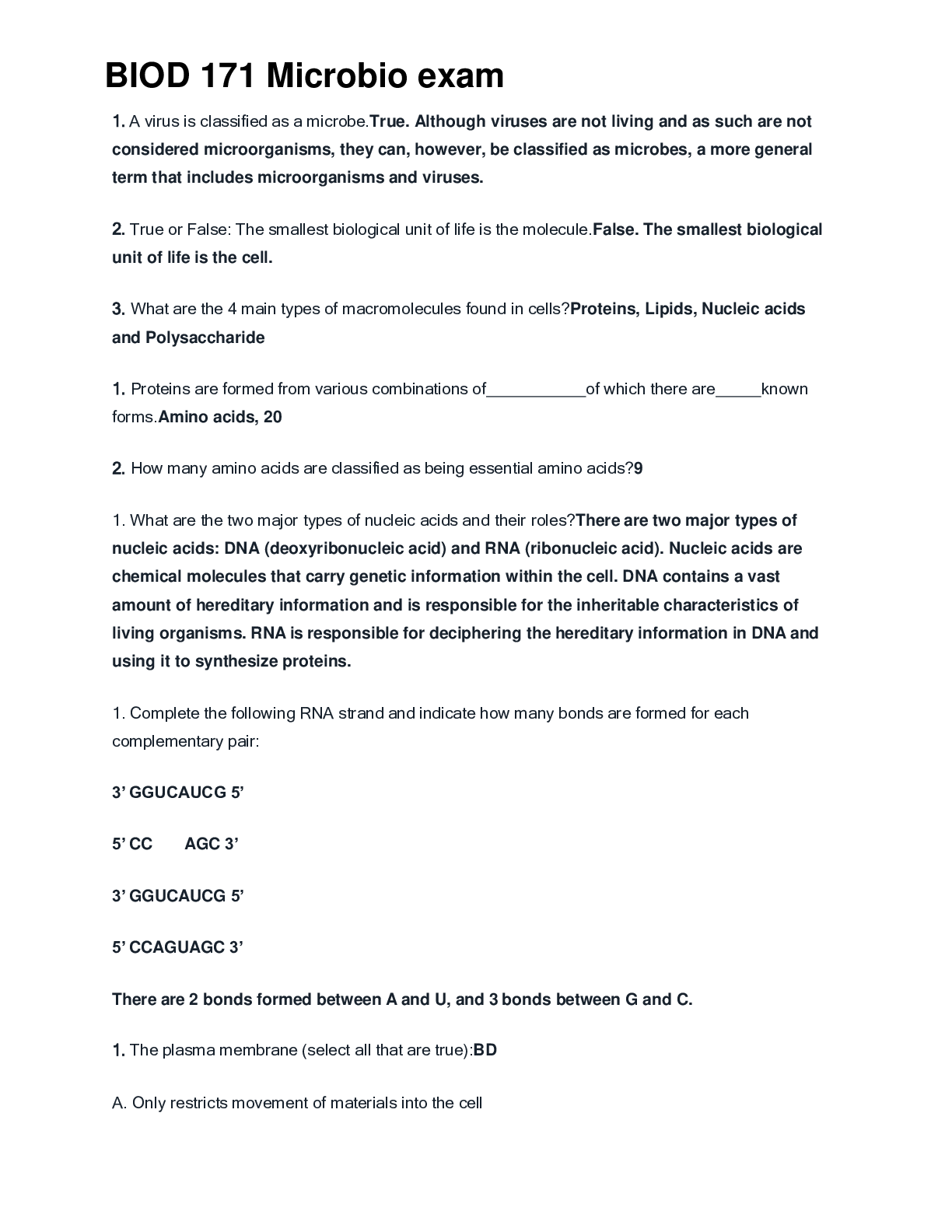
Reviews( 0 )
Document information
Connected school, study & course
About the document
Uploaded On
Aug 11, 2022
Number of pages
29
Written in
Additional information
This document has been written for:
Uploaded
Aug 11, 2022
Downloads
0
Views
51
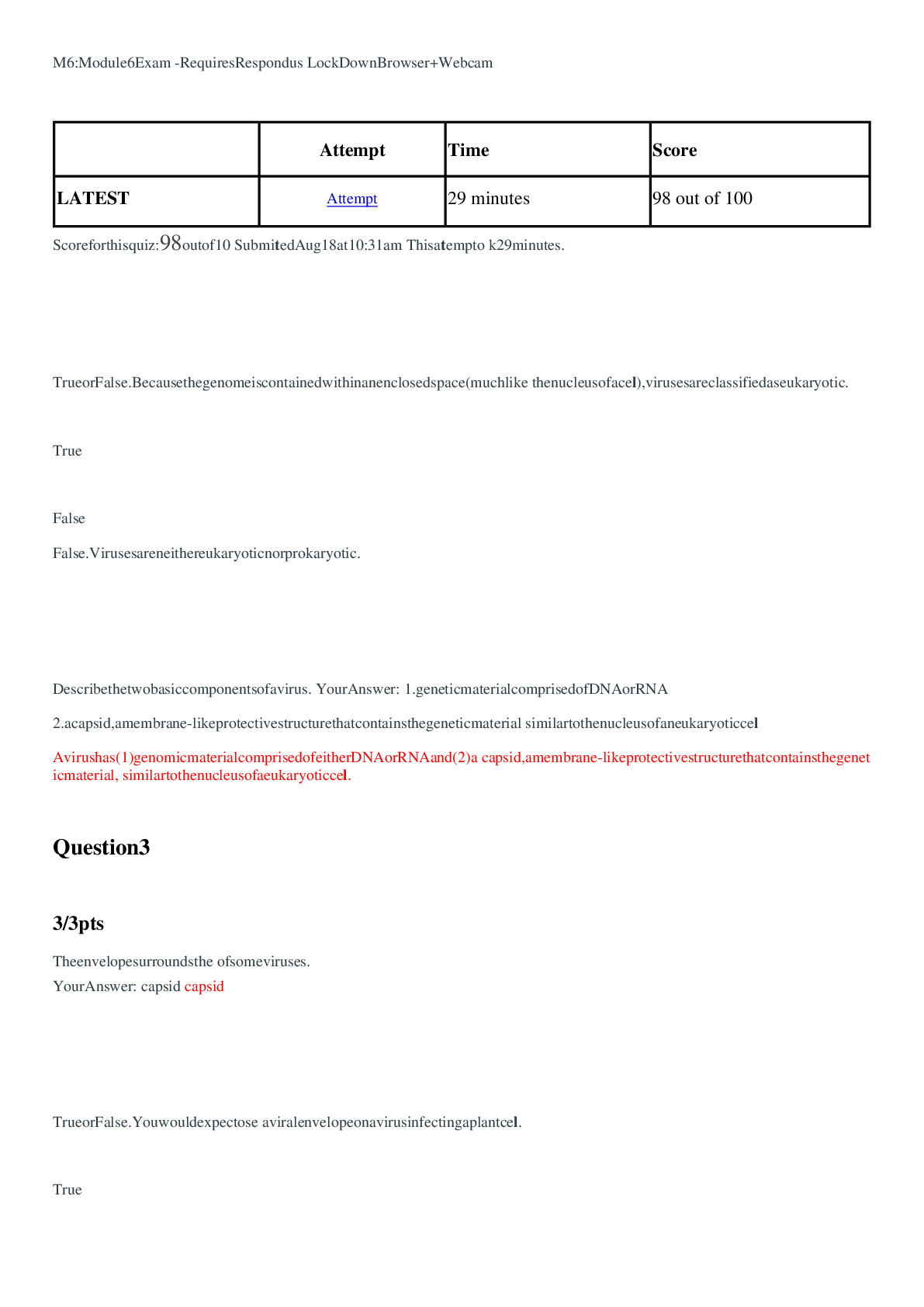






.png)










